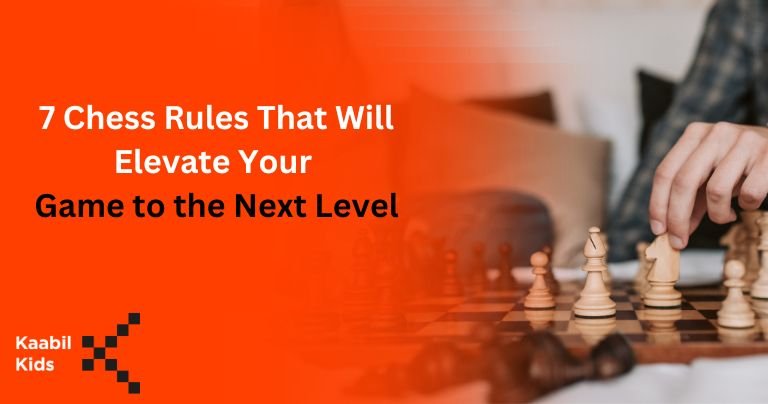Chess has captivated the minds of strategists and thinkers for centuries. While it has a reputation for complexity, at its core, chess is a game of timeless principles and rules. For novice players looking to step up their game or experienced enthusiasts seeking a strategic edge, understanding these foundational chess rules can be the key to a checkmate.
Let’s understand these seven essential chess rules. When comprehended and acted upon, they can significantly influence one’s chess prowess.
Rule 1: Understand the Power of the Pawns
Pawns are the infantry of the chessboard. They are often overlooked due to their modest movements. But they play a crucial role in shaping the game. A well-structured pawn chain can control key squares and restrict your opponent’s mobility.
Understanding pawn structure is an art. It involves knowing when to advance them for an offensive push or when to maintain the defense.
Pawn Chains and Central Control
A pawn chain is a connected group of pawns extending from one side of the board to another. When utilised effectively, these chains can possess significant control over the centre. This is critical for battleground dominance and facilitating the movement of your heavier pieces.
Pawn Islands and Weaknesses
A pawn island is an isolated group of pawns with no adjacent pawns on a file. Players should be wary of creating too many islands. This can lead to pawn weaknesses that your adversary can exploit. It undermines your defensive structure.
Rule 2: Develop Your Pieces Early
Piece development is fundamental in chess. Bringing your knights and bishops out into the game allows you to create threats, control the centre, and prepare for castling. Neglecting piece development can lead to a cramped position. This makes it difficult to manoeuvre and change your tactics.
The Opening Game
The first few moves of any game constitute the opening. This is where piece development matters most. Focus on quick, harmonious development. By move 10, you should aim to have all your minor (knights and bishops) and major (queen and rooks) pieces controlling the board optimally. This establishes a strong foundation for your mid- and late-game strategies.
The Power of Coordination
Developing pieces in harmony and working in pairs to control key squares is essential. For instance, coordinating your queen and bishop to eye the f7 or f2 square can spell danger for an opponent who has not adequately developed their pieces.
Rule 3: Control the Center of the Board
The centre is the heart of the chessboard. Controlling it awards numerous advantages. They include better mobility for pieces, the ability to launch attacks along various lines, and the creation of potential outposts for knights. By controlling the centre, you control the pathways for your opponent’s pieces and can also confine their power.
Center Pawns
Placing pawns in the centre can be a decisive move. The e4 and d4 pawn advances, for example, provide control over the critical e5 and d5 squares. It lays a solid foundation for your pieces to operate from.
Outflanking Your Opponent
From the centre, you can outflank your adversary’s pieces. This forces them to the edge of the board, where their scope is limited, or you can capture the centre to set the stage for a multi-directional attack.
Rule 4: Castle Early for King Safety
King safety is non-negotiable in chess. Castling offers the most efficient way to secure the king’s position by placing it behind a wall of pawns. This makes it significantly harder for opponents to launch an early checkmate.
Choosing the Right Time to Castle
Castling early is generally recommended to safeguard your king. It is also essential to gauge the position and readiness of your pieces. An overly aggressive castle can sometimes backfire if you haven’t developed your pieces to support your king’s position after casting.
Short and Long Castling
Chess offers two options for castling: kingside (short) and queenside (long). Each comes with its own set of advantages and tactical considerations based on the board position and the unfolding game.
Rule 5: Know When to Trade Pieces
Sometimes, the best move is to exchange your pieces for those of your opponent. Trading unequally (e.g., a bishop for a knight) can work in your favour. It depends on the position. However, strategic piece trading requires careful consideration. You don’t want to help your opponent’s development or strengthen their position inadvertently.
Material Advantage
Understanding the relative value of pieces is crucial. While the queen is the most powerful piece, trading it for more minor pieces may give your opponent a development advantage. It’s always important to consider the position and not just the material count.
Endgames and Piece Activity
In the endgame, the activity of your remaining pieces becomes more critical than their individual values. Trading down to a favourable endgame position can often lead to victory. But this requires a nuanced understanding of endgame strategy.
Rule 6: Plan Ahead and Visualize Moves
Chess is a game of planning and visualisation. Skilful players can anticipate several moves ahead, plotting out a series of strategic and tactical manoeuvres. Visualisation is crucial for mapping out these potential paths to victory.
The Importance of a Plan
Having a plan keeps your moves focused and purposeful. Whether it’s a pawn break to open a file or a strategic manoeuvre to pressure your opponent’s weaknesses, a plan gives your game direction.
Seeing the Board
Developing the ability to see the board from your opponent’s viewpoint as well as your own can uncover their plans and give you a tactical advantage. This skill is known as board vision. It allows you to perceive threats and opportunities that may otherwise be missed.
Rule 7: Learn from Every Game
Every game of chess is a learning opportunity. Analysing your own games can provide invaluable insights into your strengths and weaknesses, whether you win, lose, or draw. Furthermore, studying grandmaster games and game databases can offer inspiration and knowledge on advanced strategies and tactics.
Post-Game Reflection
Take the time to reflect on your games. What moves worked well? What decisions led to problems? Honest post-game analysis, possibly with the input of a coach or through chess software, is vital for improvement.
The Role of Education and Experience
Chess is not just about playing. It’s about continuous learning. Education through books, tutorials, and classes, coupled with experience gained from regular play and competition, is the path to mastery.
How Kaabil Kids helps?
Kaabil Kids offers a dynamic and immersive environment. It is tailored to nurture young chess enthusiasts into strategic masters of the game. Through innovative methods and personalised guidance, Kaabil Kids equips children with the tools and mindset necessary to excel in the seven essential chess rules.
KaabilKids emphasises the fundamental importance of understanding the power of pawns. Through interactive lessons and practical exercises, young learners grasp the details of pawn structures, chains, and islands. They learn to appreciate the strategic significance of pawns in controlling key squares and shaping the battlefield. This lays a solid foundation for advanced gameplay.
Piece development is a cornerstone of chess strategy. Kaabil Kids instils this principle through engaging tutorials and practice games. Children are encouraged to develop their knights and bishops early. They learn to master the art of harmonious piece coordination. By improving their opening game strategies, young players gain confidence in navigating the complexities of the chessboard with foresight and precision.
Controlling the centre of the board is essential for dominance in chess. Kaabil Kids cultivates this skill through interactive lessons on central pawn advances and positional play. Children learn to outflank opponents and seize control of critical squares. This empowers them to dictate the flow of the game and confine their adversaries’ movements.
King safety is essential in chess. Kaabil Kids emphasises the importance of timely castling and strategic positioning. Through simulated scenarios and tactical puzzles, young learners develop a keen understanding of when and how to safeguard their king. This minimises the risk of early checkmate and ensures long-term strategic advantage.
Furthermore, Kaabil Kids fosters a culture of continuous improvement through post-game analysis and access to a vast repository of grandmaster games. Children learn to glean insights from their own gameplay and study advanced strategies. This enriches their understanding of the game and fuels their passion for chess mastery.
Conclusion
Mastering these seven chess rules is by no means a guarantee of victory in every game. But it is an indispensable foundation for improving your strategic agility on the board. From understanding the tactical importance of pawns to the critical strategic moves during the opening, these rules are building blocks for enhancing your chess skills.
Whether you’re an aspiring player or a seasoned professional, incorporating these principles will undoubtedly elevate your game to new heights. Kaabil Kids provides a transformative learning experience that empowers young chess enthusiasts to master the seven essential rules of chess with confidence and finesse.
Through a blend of interactive lessons, practical exercises, and ongoing support, children embark on a journey of strategic discovery and unlock their full potential as chess players.


